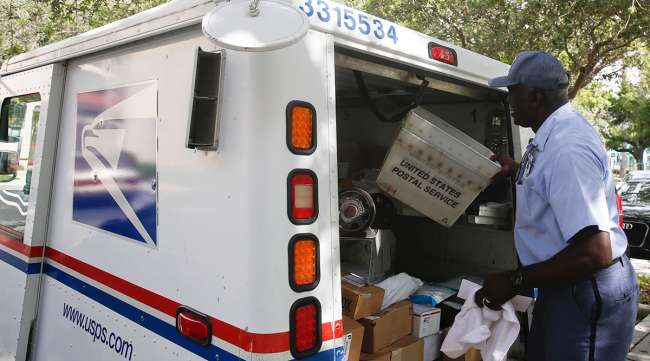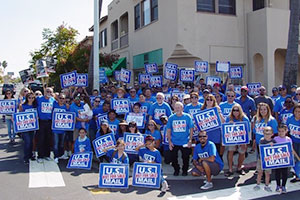Money-Losing Postal Service Hopes Trump Will Allow it to Alter Prices

A sobering review of the U.S. Postal Service by its inspector general finds that the agency’s ambitious 2015 “Window Change” program, which saves money by slowing letter delivery and closing and consolidating mail-processing centers, has cost more and saved far less than planned.
So after years of cutbacks as Americans abandoned letter-writing for e-mails and texts, the money-losing postal service is counting on the Trump administration’s so-far secret postal task force report to recommend steps allowing the agency to exploit a national boom in direct sales and package delivery.
For now, the Trump administration is sitting on the reform plan it completed in August and doesn’t plan to make it public until after next month’s congressional elections, reports Eric Katz in Government Executive, citing government sources. Postal officials hope Trump will free the post office to reprice deliveries for market conditions, sometimes raising rates without congressional action, so it can cut its losses and expand specialized sales.
Audit Report: Operational Window Change Savings by Transport Topics on Scribd
Smartphones, security and transaction tech have made modern purchasing easier from remote locations. But someone still has to truck the stuff to businesses and homes. So post offices are handling a lot more packages — but far fewer letters — in this digital-distribution era.
Unlike for-profit companies, the postal service has the mandate and the infrastructure to deliver in remote areas. So private-sector giants Amazon.com, FedEx Corp. and UPS Inc., which long have cherry-picked lucrative postal markets, have ended up hiring and relying on the postal service to help get America’s items delivered to remote areas.
In its most recent quarterly report — April through June — the postal service said revenues rose last year, to $17.1 billion, from $16.7 billion a year earlier. First-class mail fell by $134 million, to $5.9 billion, while marketing mail rose by just $63 million to $3.9 billion. But shipping and package sales, by contrast, rose by $475 million — more than 10% — to $5.15 billion.
The service lost $1.5 billion for the quarter, more than the $1 billion it lost the previous spring, after discounting special charges. Megan J. Brennan, the service’s CEO, blamed “a flawed business model that is imposed by law” and asked the government for “a less rigid and more responsive pricing system.”
Leaders of the National Association of Letter Carriers labor union called on Congress to allow the post office to raise rates, which it said are some of the lowest among developed countries. The Trump administration last week withdrew from an international postal treaty that allowed companies to mail products from China to U.S. consumers at rates far lower than U.S. shippers have to pay, which had made U.S.-made products less competitive.

South Dakota rally of USPS workers against privatizing the industry. (Michael Shea/Flickr)
U.S. Treasury, budget and personnel leaders on Trump’s postal task force met with big postal customers and labor unions through the summer while shaping proposals for the service’s future. Government Executive’s Katz writes that task force members talked to postal users and worker reps about Trump’s proposal to privatize post offices, which is unpopular in Congress. They didn’t talk about his demand to charge Amazon more for delivering packages, which had stumped postal leaders because contract package delivery for Amazon and other shippers is a popular and growing postal service.
The task force was charged by Trump with re-examining the postal service’s job “in light of changes in technology, e-commerce, marketing practices and customer needs” and the renewed importance of the agency’s mission to deliver even in unpopular remote areas.
Congressional leaders of both parties have been hoping the task force also will support proposals to ease the service’s up-front health and retirement funding requirements, so it could eliminate its operating deficit and expand its business.
The postal inspector general found that trying to “process mail on fewer machines” and “shifting some mail from a two-day to a three-day service standard,” which postal officials projected would save $1.6 billion over the past two fiscal years, had saved a far more modest $323 million, mostly through future “cost avoidance.” This effort included shutting down 17 mail-processing facilities and partial consolidation of 21 others, increased automation of sorting and other jobs done by hand, and the use of larger, but slower, mail-sorting runs.
Instead of hoped-for savings, total mail processing costs increased by $153 million over the past two years, the inspector general found. Higher transportation costs have added $1 billion more to postal service expenses. Overtime rose by $68 million. Mail-processing improvements were supposed to save $1 billion, but productivity fell, canceling most of the expected savings.
“Management said they remain optimistic they will achieve the full savings” and insisted they were part way there, the report said. But auditors were unable to confirm much of the savings that the agency reported and concluded that the postal service likely would not achieve its goal.
Trump has lately hurried to fill some of the vacancies on the postal board of governors so it will have enough members to vote on any proposals from his administration’s task force.
Distributed by Tribune Content Agency, LLC




